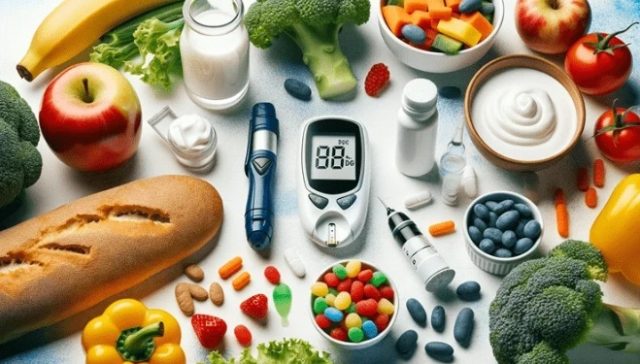
Type 2 Diabetes can lead to complications that affect our life expectancy, such as kidney disease. Over time, diabetes can damage blood vessels in the heart, eyes, kidneys and nerves. People with diabetes have a higher risk of health problems including heart attack, stroke and kidney failure. Diabetes can cause permanent vision loss by damaging blood vessels in the eyes. However, proper medication and certain lifestyle changes can help prevent diabetes complications and give you a healthy life. Here’s taking a look at how this can be achieved!

Manage your weight
If you are having Type 2 diabetes, then it is necessary to manage your weight. Being overweight or obese increases the risk for high blood cholesterol and high blood pressure, which are risk factors for cardiovascular disease. Two ways to help manage weight are to eat healthy and be more physically active. For losing weight, it is advisable to eat fewer calories as compared to what you are eating daily and at the same time, workout is necessary. For a person living with diabetes, physical activity and weight management can help control the disease and minimize negative health consequences. Keep your blood glucose well controlled to stay energetic.
Get your check up done regularly

Dr. Rahul Jain, MD Internal Medicine Specialist, Belle Vue Clinic, Kolkata suggests that it is very important that a diabetic person sees a doctor at least once in three months. He suggested, “A diabetic person should visit a doctor once in every 3 to 4 months. The visit should include inspection of the feet, inspection of blood pressure, pulse, sugar fasting and postprandial, Glycated Haemoglobin or HbA1c, retina check up at least once every year, blood cholesterol level – lipid profile test at least once a year, ECGs should be done depending upon the heart condition of the person and Creatinine test- the frequency of which depends upon the stage of the disease.”
What to eat and why
What we eat, how we eat and when we eat plays an important role when it comes to managing diabetes.
High-fibre diet
Dietary carbohydrates that are higher in fibre and less refined can be a good choice to manage your blood glucose levels. Brown rice is perfectly safe to eat in moderation if you have diabetes. While it’s high in carbs, its fibre, antioxidants, vitamins, and minerals may improve blood sugar control, thereby helping manage diabetes.
Eating healthy
A healthy-eating plan includes knowing what to eat and how much to eat. This is very important because when a person has diabetes, what he/she eats affects their blood sugar levels. Green vegetables, fruits, whole grains, non-fat dairy (low-fat milk, yogurt or lactose-free versions such as soy milk) and lean meat are a healthy choice for those with diabetes. Protein foods, including lean meats, poultry, seafood, beans, nuts and soy products are healthy.

Carbohydrates
Carbohydrates turn into sugar, so it is necessary to watch your carb intake. This is even more important for those who are on insulin. Healthy carbs like whole fruits, vegetables and whole grains are full of nutrients and can be safely consumed. They have fibre that helps keep blood sugar levels more stable too. Refined, highly processed carbs like rice, white bread, sugary cereal, cakes, cookies, toffees and chips should be taken in limitation.
Portion control
Portion control helps to keep blood sugar level in control and also contributes in weight loss. Eating in a shorter plate and drinking a glass full of water before every meal helps in portion control. However, it is always advisable to consult your doctor or a registered dietician before making any changes to your diet.
Use diabetes-friendly recipes
Living with diabetes does not mean that you cannot have tasty, spicy delicacies and snacks. It is just that you should find recipes which offer healthier versions of the same food to satiate your cravings.

Stay hydrated
Drink plenty of water or other fluids especially while exercising. Dehydration can affect blood sugar levels.
Why a Balanced Diet is necessary
Dr. Rahul Jain suggests a balanced diet which has adequate proportions of carbohydrates, proteins and fat. Dr Jain told The CSR Journal, “Normal home-cooked food is always recommended for people living with diabetes. It is important to stick to a diabetic balanced diet which comprises of all right balance of protein carbohydrate and fat depending upon the body type. There should be intake of high quality protein which is adequate for your age and your physical activity. Normally one gram of protein per kg is the recommended for a person with ideal body weight amount unless there is a kidney problem. There should be intake of complex carbohydrates from unrefined sources like unpolished daal.”

“Unprocessed, unrefined whole grains should be consumed. Rice and cereals should be taken in lesser amount as compared to vegetables. Green leafy vegetables and green vegetables should be taken more, because these have low calorific value and are high in fibre. Fibre delays glucose spike,” he added.
What to avoid
Dr. Jain warned, “For a person with diabetes, tobacco and alcohol should be strictly avoided. There is no safe level for tobacco and alcohol. Even one drop of alcohol can be harmful. Avoid fast foods as much as you can. Also, any kind of protein supplement is harmful for diabetics because this affects your kidneys as revealed by recent ICMR (Indian Council of Medical Research) report and many diabetics already have a pre-existing kidney problem.”
“Simple carbohydrates and sugar should be avoided, starches should be avoided. Added sugar should be completely avoided. Consumption of fat should be in limited amount, fried foods should be avoided. Anything which is deep fried, processed, packed or tinned should be avoided. Any kind of health drink should be avoided,” the doctor further informed.
Limit sugary drinks
Sugar-sweetened drinks tend to be high in calories and low in nutrition. They also cause blood sugar to rise quickly. So it’s best to limit these types of drinks if you have diabetes. The exception is if you have a low blood sugar level. Sugary drinks can be used to quickly raise blood sugar that is too low. These drinks include regular soda, juice and sports drinks.

How Smoking kills
Smoking has serious health consequences for people living with diabetes. Smoking can decrease good cholesterol, temporarily raise blood pressure, increase the risk of blood clots, make it more difficult to exercise. Smokers are 30% to 40% more likely than nonsmokers to develop diabetes. If you have diabetes, smoking is even worse because you’re more likely to develop problems such as nerve damage and kidney disease, three times more likely than nonsmokers to die prematurely of heart disease or stroke, more likely to raise your blood sugar level — making it harder to control your diabetes.

Exercises for diabetes
If you’re not very active physically, it’s high time you should start. You don’t have to join a gym and do cross-training. Just walk, ride a bike, or play badminton. For a person with diabetes, goal should be 30 minutes of activity that makes you sweat and breathe a little harder at least 5 days of the week.
An active lifestyle helps a person control your diabetes by bringing down your blood sugar. It also lowers the chances of getting heart disease. Plus, it can help a person lose extra pounds and ease stress. Exercise is another important part of managing diabetes. During any kind of movement or physical activity, our muscles use blood sugar for energy. Regular physical activity also helps our body use insulin better. These factors work together to lower your blood sugar level. Even light activities like household chores, gardening and walking can improve your blood sugar level.
It is advisable to have a small snack or carry glucose tablets or toffee with you during exercise. You’ll need a quick way to boost your blood sugar if it drops too low.

Sharing his inputs on the same, Dr. Rahul Jain said, “When it comes to exercise, the idea is to start slowly and build up gradually. You have to start slowly with 10 minutes a day and continue up to 30 minutes a day of aerobic activities like walking, swimming, light aerobics etc. These are highly recommended because aerobic activities do not cause shortness of breath. Exercise up to 150 minutes per week is recommended while you can take rest for two days. Yoga is an excellent form of exercise for diabetics because this makes your body flexible and the breathing techniques help in relieving stress. This helps in reduction of resting heart rate, resting blood pressure and it is mentally very refreshing. Meditation is also beneficial if it is done properly for diabetics. Yoga and morning walk at a gentle pace, lawn tennis or table tennis, swimming are recommended for diabetics.”
Workout Warning
“Any kind of exercise should be performed under the supervision and guidance of the doctor. For someone with a diabetic foot, repeated weight-bearing exercises or regular walking can be harmful. Foot examination should be done for neuropathy or diabetic foot ulcers and proper footware should be used.
Many and diabetic patients have Ischemic heart disease. For them, gym workouts like bench press or heavy squats can be extremely harmful. Which is why, first they should get a thorough physical examination done by a physician and then embark on any exercise. If any kind of workout causes chest discomfort, shortness of breath or causes any unusual symptoms like head swinging, then it should be immediately discontinued and medical opinion should be taken,” warns the doctor.
Yoga Asanas for a healthier life
Sanghamitra Das, Yog Prashikshak, Indian Yoga Association suggests certain Yoga Asanas that can offer a healthier life to people with diabetes.
“Any twisting asana which gives a gentle massage to the pancreas is of great help. To name a few, Parivratta Trikonasana, Vakrasana, and Marichasana Variations can be beneficial for people with diabetes. The most important thing is managing your body weight and diet. So, any dynamic practices can be very helpful. Nature walks in the morning are very helpful for person who can’t practice asanas or can’t perform dynamic exercises. Classical Surya Namaskar and Surya Namaskar A and B are also helpful,” Sanghamitra suggests.

Manage your Stress
For a person with diabetes, it is important to manage stress, which affects our emotional well-being. When we are anxious or stressed, our blood sugar levels go up. Stress and anxiety can cause one to forget to exercise, eat right, or take medicines. It is necessary to find ways to relieve stress through deep breathing, yoga, or hobbies that relax you. For some people, having pets at home can be a great way to relieve stress. Keep stress under control as it may cause your blood glucose to rise. Staying calm is one of the ways to lower blood sugar.

Why work-life balance is important?
While adequate sleep and healthy eating are necessary, it is also important to check whether a diabetic person is showing signs of anxiety or depression, having disagreements with friends/family members, is overeating or refusing to eat, is not taking breaks at work.
It is important to keep a healthy balance between work and personal life for someone with diabetes. Otherwise, this can lead to the risk developing illnesses, dysfunctional relationships, and exhaustion or burnout. A person’s family, friends and colleagues have an important role to play here.
Source link
Modified by Maaaty at Cheap Generic Pharmacy

